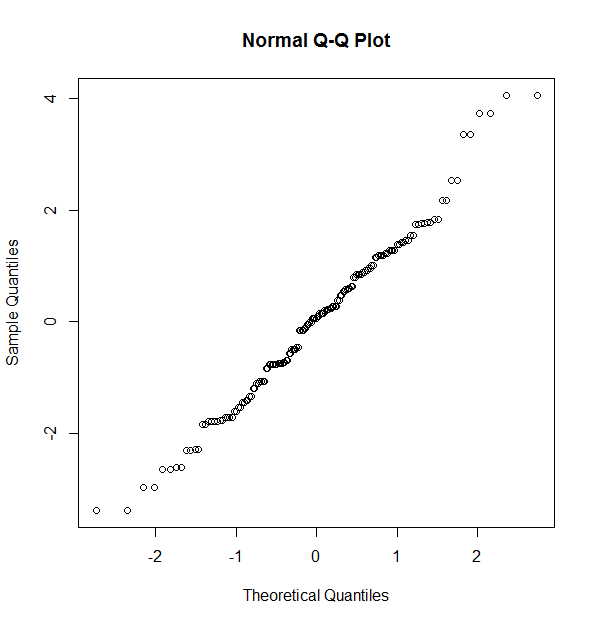I've run a fully within-subjects repeated-measures ANOVA using the aov() function. My dependent variable is not normally distributed, so I'm very interested in running assumption tests on my analysis. It seems that just calling plot() on the output doesn't work for repeated-measures, so I've manually taken the residuals and the fitted values for a model of interest, and have plotted them against each other. I'm assuming that this is how I would plot to test for the assumption of Homoskedasticity.
The plot comes out with 2 vertical bands (please see the image below). It turns out the fitted values are all centred around 2 values (although according to == they are not exactly equal), where one is the negative of the other.
I have 2 questions:
1) Is this the correct way to manually test the assumption homoskedasticity? If not, how would I go about it from repeated-measures designs (since just calling plot() doesn't work)?
2) If it is correct, what is this plot telling me? Why are the fitted values so clustered? What can I conclude from it?
Thanks heaps for any input here. Also, if you know of better ways to check (preferably plot) for assumptions in rm-ANOVAs, that would be useful information as well.
I've included some mock data here to replicate the scenario:
#Create mock data (there's probably a more efficient way to do this.. would also be nice to know! :) )
p <- sort(rep(1:20,8))
y <- rep(rep(1:2,4),20)
z <- rep(rep(c(1,1,2,2),2),20)
w <- rep(c(1,1,1,1,2,2,2,2),20)
x <- rnorm(160,10,2)
d <- data.frame(x,p=factor(p),y=factor(y),z=factor(z),w=factor(w))
#Run repeated-measures ANOVA
ex.aov <- aov(x ~ y*z*w + Error(p/(y*z*w)), d)
#Try to plot full object (doesn't work)
plot(ex.aov)
#Try to plot section of object (doesn't work)
plot(ex.aov[["p:y:z"]])
#Plot residuals against fitted (custom "skedasticity" plot - works)
plot(residuals(ex.aov[["p:y:z"]])~fitted(ex.aov[["p:y:z"]]))
Begin Edit
In light of the information provided by @Stefan , I've added some additional details below, using the improved data structure he proposed:
# Set seed to make it reproducible
set.seed(12)
#New variable names and generation
subj <- sort(factor(rep(1:20,8)))
x1 <- rep(c('A','B'),80)
x2 <- rep(c('A','B'),20,each=2)
x3 <- rep(c('A','B'),10, each=4)
outcome <- rnorm(80,10,2)
d3 <- data.frame(outcome,subj,x1,x2,x3)
#Repeated measures ANOVA
ex.aov <- aov(outcome ~ x1*x2*x3 + Error(subj/(x1*x2*x3)), d3)
#proj function
ex.aov.proj <- proj(ex.aov)
# Check for normality by using last error stratum
qqnorm(ex.aov.proj[[9]][, "Residuals"])
# Check for heteroscedasticity by using last error stratum
plot(ex.aov.proj[[9]][, "Residuals"])
The resulting plots are below:
Can anyone interpret the images above (especially the last one)? It looks like there is clustering and pattern structure. Can it be used to infer the presence of heteroskedasticity?






